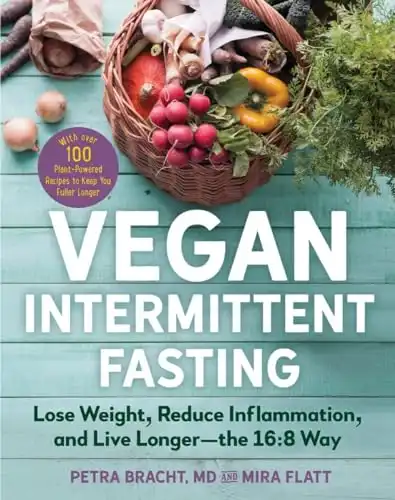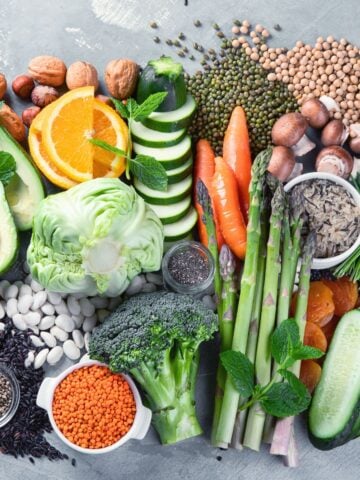Intermittent fasting isn’t just a fad diet; it’s an intuitive way of eating for your physical body and has many health benefits. However, you may wonder if you should try it if you follow a vegan lifestyle. In this complete guide, I will tell you everything you need to know about vegan intermittent fasting so you can decide whether it is right for you.

Jump to:
- What is intermittent fasting?
- What is vegan intermittent fasting?
- Benefits of Intermittent Fasting
- Risks of Combining a Vegan Diet with Intermittent Fasting
- Is Vegan Intermittent Fasting Right For Me?
- People Who Should Avoid Intermittent Fasting
- Fasting Hour Options
- How to Get Started
- Intermittent Fasting FAQS
- Resources to Help You Get Started
- Final Thoughts
- More helpful vegan tips!
What is intermittent fasting?
Intermittent fasting focuses on when you eat instead of what you eat. The best way to explain it is that you fast or go without eating for a specified number of hours, allowing your body to burn body fat more easily, before breaking your fast by eating a meal.
You naturally fast every day from after dinner to the next morning when you have breakfast. That is, unless you’re a midnight snacker!
When you practice intermittent fasting it’s helpful to ensure you get plenty of water and some protein and satiable fat source in your meal of choice to help you stay full, happy, and healthy during your fasting periods. Nobody wants a fasting friend or family member, right?
As a result of limiting the hours in which you eat, people generally eat fewer calories, resulting in the calorie deficiency needed to lose weight. In addition, fasting helps your body burn fat more quickly. This is why it has become a widespread lifestyle shift and weight loss method. You can follow a fasting plan when on other types of diets, such as the keto diet, paleo, whole 30, or any healthy diet.
What is vegan intermittent fasting?
Vegan intermittent fasting is similar to regular intermittent fasting. The only difference is that you follow a vegan diet during your eating window. You must make sure that you make smart food choices that include whole foods, plant-based proteins, and fat sources. For example, you could prepare this high-protein overnight oat with a dollop of peanut butter for added fat. The most important thing to consider when fasting and following a vegan diet is to choose well-balanced meals that include plenty of protein and healthy fats to keep you full and satiated between meals.
Benefits of Intermittent Fasting
Following a plant-based diet while incorporating intermittent fasting into your lifestyle can be done and provides better health overall.
Health benefits of fasting include but are not limited to:
- Increase life expectancy
- Lower blood pressure
- Lower BMI
- Decrease the risk of heart disease
- Lower Cholesterol
- Improving focus and brain health
- Weightloss
- Overall gut health
- Increase endurance and overall energy and mood
- Increase muscle mass
- Help you develop healthier eating habits
- Decrease bloating
- Improve energy levels
Risks of Combining a Vegan Diet with Intermittent Fasting
Following a vegan diet, when not done thoughtfully, can unknowingly omit many nutrients your body needs. Be sure to plan your meals for a well-balanced meal that includes protein, fat, vegetables, and whole grains.
It would be best to ensure that the meals or smaller meals you eat in your allowed eating window will meet your macro needs.
Vitamin B-12 is one of the vitamins that can be difficult for vegans to consume since it is most often found in animal protein. However, B12 can be found in nutritional yeast, cereals, mushrooms, and algae.
Iron is another nutrient vegans can quickly become deficient in without even realizing it. This is a problem for both vegans and carnivores and something to track no matter what lifestyle you plan to follow.
Zinc, Calcium, and Vitamin D are other nutrients in which vegans can be deficient. Don’t become malnourished by following a poorly planned plant-based diet. This problem can affect not just your mood but also your overall health and development.
It would be helpful to take a vegan multivitamin or other supplements while following a vegan diet to ensure you get the proper nutrients your body needs. However, taking a multivitamin should not substitute healthy, well-balanced meals.
You may also find that when you start fasting, you experience more side effects, such as hunger pains, headaches, lethargy, and heartburn. These are all relatively mild side effects that subside with time.
Before starting this lifestyle change, discuss any potential side effects and how to handle them with your health team.
Is Vegan Intermittent Fasting Right For Me?
Intermittent fasting is a good option for otherwise healthy individuals looking to lose the last 5 to 15 stubborn pounds, those who have hit a diet plateau, or those who want to jump-start their weight loss journey.
Before embarking on vegan intermittent fasting, it is essential to discuss these changes with your healthcare provider. While it can be highly beneficial for many people, you should always discuss your nutrition plans and dietary habits with your doctor to ensure they will be safe and effective for your health journey.
If you and your doctor decide this is a beneficial option, I have a few recommendations to help you start and succeed.
People Who Should Avoid Intermittent Fasting
Do not start intermittent fasting if you are…
- Diabetic (fasting can cause low blood sugar levels)
- Pregnant or thinking about becoming pregnant
- Breastfeeding
Be sure to discuss your eating plan with your doctor if you become pregnant while following a vegan diet and/or practicing intermittent fasting.
Fasting Hour Options
16:8
The 16:8 option is the most common fasting option individuals choose. For this option, you can eat during an 8-hour window, and your fasting period will be 16 consecutive hours. However, if you are starting, you can start fasting 12 hours a day and work towards a 16-hour fast.
One of the easiest ways to do this is to see how long you sleep and tack on a few hours on each end to make up your 16 hours of fasting. For example, say you sleep from 9 pm to 5 am each night. Half of your fasting hours are already taken care of while you do nothing but sleep. Now add on 4 hours before you go to bed and 4 hours after you wake up.
So, you will fast from 5 pm (typically after dinner) until 9 am the following morning (a later breakfast or brunch time). The actual hours of the day you choose don’t matter as long as the ratio is the same.
5:2
This form of fasting is slightly different from the 16:8 plan. This is more focused on what you’re eating each day. fasting time
Under this plan, you’ll eat your regular vegan diet for five days, and the other two days a week, you will limit your calorie intake to about 500-600 calories a day. The fasting time each day isn’t as important as limiting your calorie intake on the other days.
Alternate Day Fasting
This lifestyle combines the two options above. On the first day, you’ll start with a limited caloric intake day of 500-600 calories, and the next day, you’ll follow a 16:8 fasting and eating window. fasting and feasting window day.
This is a great way to shake up your metabolism if you are at a plateau or need a change.
How to Get Started
I suggest you start with the 16:8 protocol. This is the most intuitive of all the options and can yield excellent results.
Step 1: An easy way to start is to note your last meal or snack before bed. Try to finish your dinner between 6 pm and 7 pm, and don’t snack in the evening.
Step 2: When you wake up in the morning, skip your usual breakfast or prolong your breakfast depending on when you had your last meal. For example, if you finish eating dinner at 6:00 pm, then wait to have breakfast until 10:00 am. That would be a 16-hour fast. Adjust the time to break your fast depending on your last meal.
Step 3: During your 8-hour eating window, enjoy healthy, well-balanced meals that include protein, fat, vegetables, and high-fiber carbohydrates.
Step 4: Finish your last meal between 6-7 pm. Then repeat the process.
Intermittent Fasting FAQS
The answer to this will vary from person to person, depending on your personal and medical history and the goals you desire to achieve while fasting. If you are starting intermittent fasting to lose weight, you will likely have to fast until you reach your weight loss goals. However, once you reach your weight loss goal, you want to continue to eat a healthy, well-balanced diet to maintain your weight loss.
Fasting works by extending the period that your body is in calorie-burning mode after it burns all the calories from your previous meal. Your body stores the calories you consume in either glycogen or body fat. Your body first stores calories in glycogen, but any extra calories your body doesn’t need get stored as body fat. Every time you eat, you are rebooting your system, which doesn’t allow your body to start burning fat. Fasting gives your body the time it needs after it burns through your regular calories to start burning fat stores.
Fasting and following a healthy plant-based diet may help you lose weight. But as with all diets, it’s not one size fits all. How much weight you lose depends on many factors, including exercise and calorie restriction. If your goal is to lose weight due to intermittent fasting, be sure also to include an exercise program and make healthy eating choices during your eating hours. Just because it is your window to eat does not mean you should consume all the junk food you want!
You may exercise while fasting, but you may also find that you fatigue much faster than you do during your feasting window. If you choose to exercise during a fast, consult your doctor. You should probably select low-intensity exercises like walking, pilates, or yoga and avoid things like HIIT workouts. Leave that for your eating window.
Yes, you may drink water while fasting, which is highly encouraged. Water will help you feel full longer, help promote your body to lose weight if necessary, and provide your body with proper hydration.
You may also drink black coffee or herbal tea during a fasting window but do not add sugar or dairy-free cream. Discuss with your health team what beverages would be best for you while fasting. Typically, it’s water, but some individuals are allowed to have up to 50 kcals while fasting and will remain in a fasting state.
Resources to Help You Get Started
Vegan Intermittent Fasting By Petra Bracht is an excellent book for those who want a comprehensive plan. This book follows the 16:8 fasting plan. It thoroughly explains how fasting works and its benefits, such as weight loss and reduced inflammation. In addition, it contains over 100 recipes that ensure you follow a well-balanced nutrient-rich diet plan while fasting.
Plant-Based Grocery List: This is a complete and comprehensive shopping list of all the plant-based foods that will help you prepare delicious and well-balanced meals.

WFPB Diet The Ultimate Guide: If you are just getting started, this complete vegan guide will tell you what it entails, how it’s different from other diets, the benefits, and the steps to getting started.
Vegan Meal Plan: This is a great starting point for meal planning while fasting. It includes delicious recipes and tips on how to plan a thoughtful, well-balanced vegan meal.
Final Thoughts
Remember to plan your meals properly during your feasting window. Fruits and many plant-based foods will digest faster and may leave you feeling hungry more quickly than you anticipated. Be sure to eat foods with a slower digestion time and higher satiety factor to help you succeed in following a vegan intermittent fasting lifestyle. As time passes, analyze your vegan diet and fasting protocols with your healthcare team and adjust based on your nutrition needs as necessary.
More helpful vegan tips!
Please comment below if you found this article helpful or have any additional questions. You can also follow me on Instagram, Pinterest, and Facebook for more family-friendly vegan recipes!








Leave a Reply